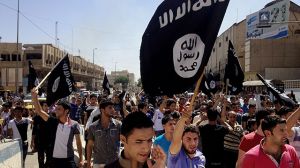
Demonstrators chant pro-al-Qaida-inspired Islamic State of Iraq and the Levant (ISIL) as they carry al-Qaida flags in front of the provincial government headquarters in Mosul, 225 miles (360 kilometers) northwest of Baghdad, Iraq, Monday, June 16, 2014. (AP Photo)
Ed note: This post is excerpted from our June backgrounder, “Iraq Is Coming Apart at the Seams — Here’s Our Essential Reader“
Who Are These Islamic State Guys?
IS is a group of violent Islamic fundamentalists that first formed in Iraq in the aftermath of the US invasion as Jama’at al-Tawhid wal-Jihad, or “The Organization of Monotheism and Jihad.” It has gone by many names; today, it is also known as the Islamic State, The Islamic State of Iraq and Syria (ISIS) and the Islamic State of Iraq and the Levant (ISIL). As the latter name implies, they ultimately aspire to create an ultra-conservative Islamic state in Iraq, Syria, Lebanon, Israel, Jordan, Cyprus and Southern Turkey.
To simplify a complex history, the organization, which was most familiar to Americans as “Al-Qaeda in Iraq,” began in late 2004 as a home-grown Iraqi Sunni insurgency group that pledged allegiance to Osama Bin Laden. It has expanded into Syria during that country’s civil war, where it attracted extremists from around the world and grew in numbers and strength. Last October, Liz Sly reported for The Washington Post that “thousands of Arabs and other non-Syrian Muslims” had “streamed into Syria over the past two years to join in the fight.”
Experts say that IS has now become so powerful and well-organized that it’s misleading to call it a “terrorist group.” Jessica Lewis of the Washington-based Institute for the Study of War told Time Magazine that it now has “an advanced military leadership… They have incredible command and control and they have a sophisticated reporting mechanism from the field that can relay tactics and directives up and down the line,” she said. “They are well-financed, and they have big sources of manpower, not just the foreign fighters, but also prisoner escapees.”
Martin Chulov reports for The Guardian that IS has “secured massive cashflows from the oilfields of eastern Syria, and supplemented those revenues by robbing banks and looting antiquities.” According to Chulov, the network may have access to $2 billion.
Writing for The Atlantic, Aaron Zelin notes that IS has established a very severe form of Islamic law in areas it has occupied, while also employing “a soft-power governing strategy that includes social services, religious lectures, and da’wa (proselytizing) to local populations.” And at The Nation, Robert Dreyfuss suggests that there’s “a real danger that ISIS and its allies can set up a rump statelet in northwest Iraq and northern and eastern Syria controlled by ISIS, and its allies, including groups more closely affiliated to Al Qaeda.”
What’s the Regional Context Here?
This is both an Iraqi conflict, and also a tangled web of proxy wars fought along various regional fault lines.
This chart, by Hayes Brown and Adam Peck from ThinkProgress, is a helpful guide to all of the parties in this highly interconnected conflict:
(Image: ThinkProgress)
Media accounts often focus on the discord between the Gulf states, led by Saudi Arabia, and the “Shiite crescent” — Iraq and Iran, where Shiites are the majority; Lebanon, where Hezbollah is a powerful faction; and Syria, where the Alawites (an offshoot of Shia Islam) are a dominant minority. As the chart above illustrates, this tension also affects Turkey, which has launched multiple strikes against Kurdish separatists in Iraq, and the Israeli-Palestinian conflict.
The Pew Research Center finds that throughout the region, from Tunisia to Egypt, there are “widespread fears” that the “violence in Syria would spill over into neighboring states.”
Are We Responsible for This Mess?
That’s an oversimplification.
It also takes a short view of history: As the birthplace of the three major Abrahamic religions — and the repository for a good chunk of the world’s oil reserves — the Middle East has long been plagued by conflict. The European colonial powers that sliced up the territory according to their own needs also deserve a lot of credit for its current instability — at GlobalPost, Charles Sennott writes that ISIS is in the process of “tearing up the map” created by France and Great Britain during World War I.
That said, it’s impossible to deny that the US invasion of Iraq in March 2003, plus a series of ideologically informed decisions by the Bush administration that followed, is the proximate cause of the bloody conflict raging there today.
The Bush administration went into Iraq with a “small footprint” — that is, insufficient forces to provide security — fired the army and police as part of its “de-baathification” program, privatized the Iraqi economy instead of investing in adequate public services and established a Shiite-dominated government that marginalized the Sunni community.
At The New Yorker, Dexter Filkins argues that the current wave of extremism in Iraq is “America’s legacy.” He writes: “When the Americans invaded they destroyed the Iraqi state—its military, its bureaucracy, its police force, and most everything else that might hold a country together.”
In 2004, The Atlantic’s James Fallows reported that “the Administration will be condemned for what it did with what was known. The problems the United States has encountered are precisely the ones its own expert agencies warned against.” Naomi Klein reported for Harper’s that the administration’s free-market ideology was the root cause of many of the problems that plagued US reconstruction efforts. In 2007, Nir Rosen wrote in The Washington Post that an “obsession with sects informed the U.S. approach to Iraq from day one of the occupation, but it was not how Iraqis saw themselves — at least, not until very recently. Iraqis were not primarily Sunnis or Shiites; they were Iraqis first, and their sectarian identities did not become politicized until the Americans occupied their country, treating Sunnis as the bad guys and Shiites as the good guys. ” That same year, Raed Jarrar and I said that US officials in Iraq had thwarted a number of plans for peace and reconciliation that had been put forth by parties that opposed the occupation.
The US also played a major role in Nouri al-Maliki’s rise to power following the handover from the Iraqi Coalition Government. Maliki has governed in a fiercely sectarian manner — Al-Monitor states that many “inhabitants of Mosul see the Iraqi army as a Shiite occupation army from Baghdad, and some civilians welcomed ISIS when they entered Mosul and removed all Iraqi army checkpoints. And while The Washington Post’s David Ignatius wrote back in 2007 that “the most important fact about Maliki’s election is that it’s a modest declaration of independence from Iran,” Maliki spent a decade in exile in Iran and, despite some ideological differences, the party he heads, Dawa, has received consistent support from Tehran.
Dexter Filkins reported for The New Yorker that a crucial deal that brought the current Iraqi government together was orchestrated by Qassem Suleimani, the head of Iran’s Quds Force and the architect of Syrian President Bashar al-Assad’s war against the Syrian insurgency.



